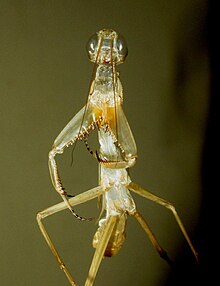African praying mantis
| African praying mantis | ||||||||||||
|---|---|---|---|---|---|---|---|---|---|---|---|---|

African praying mantis ( Sphodromantis gastrica ), female |
||||||||||||
| Systematics | ||||||||||||
|
||||||||||||
| Scientific name | ||||||||||||
| Sphodromantis gastrica | ||||||||||||
| ( Stål , 1858) |
The African praying mantis ( Sphodromantis gastrica ) is a fishing insect from the Mantidae family . It is also known as the green praying mantis , although this common name is also used for the closely related African giant mantis ( Sphodromantis viridis ).
features
The stronger females of the African praying mantis reach a length of approx. 80 millimeters, the narrower males one of approx. 60. Another distinguishing feature of both sexes is the number of segments of the abdomen in addition to the body structure. There are eight in the male and six in the female. The African praying mantis shares this quality with all other mantis. The basic color of the African praying mantis can be yellow, green or brown. The physique corresponds to that of other species of the family Mantidae and is accordingly quite robust compared to that of other catching horrors. The inside of the tentacles and parts of the underside of the wings are yellow and are used for defense.
Similar species
The African praying mantis is similar to other members of the family, particularly closely related species of the same genus, such as the Ghana praying mantis ( Sphodromantis lineola ), the African giant mantis ( Sphodromantis viridis ) or Sphodromantis bacetti . It is also similar to species of the genus Hierodula , such as the Indian giant mantis ( Hierodula membranacea ).
Occurrence
The African praying mantis is represented in almost all countries in southern and eastern Africa . Their habitat is formed by the foliage and branches of bushes and trees as well as shrubs and grasses in arid regions.
Way of life
The African praying mantis, like many mantis, is well camouflaged in its habitat and mostly remains motionless there in favor of it. Like other mantids, the animals can also defend themselves with a threatening gesture or, if necessary, the tentacles or bites. Furthermore, in contrast to the predominantly flightless females, the males can use their ability to fly. The African praying mantis is a prey hunter who, like other terrors, seizes other prey in a matter of milliseconds with its tentacles and then consumes it.
Reproduction
Like the other species of the genera, but unlike many other fishing horrors, both sexes require the same number of molts (ten) to reach adulthood. Nevertheless, the time it takes to reach sexual maturity also differs here. The male is sexually mature after two weeks, the female only after three weeks. A female willing to mate attracts a male with the help of pheromones. The duration of the pairing is six to 18 hours. The cannibalistic behavior that occurs in mating, especially during mating, is also present in the African praying mantis. About four weeks after mating, the female lays the first ootheca , followed by four to six more at an interval of two to four weeks. The oothecae are semicircular in shape and have a dark to brown basic color. Their diameter is around 40 millimeters and they contain up to 250 eggs. The young then hatch four to six weeks after being deposited and are initially around six millimeters in size. As with other fishing rods, the nymphs can adapt their color to their respective habitat during molting and thus change it. Life expectancy can be up to one year for males and up to one and a half years for females.
Keeping in the terrarium
The African praying mantis is a popular terrarium animal due to its ease of care, which it shares with the other species of the genus.
Systematics
The African praying mantis was first described by Carl Stål in 1858 as the Mantis gastrica . Then it was classified as Hierodula bicarinata by Henri de Saussure in 1969 and as Sphodromantis guttata by Ermanno Giglio-Tos in 1907, before it was later given its current name.
gallery
Individual evidence
- ↑ a b c d Posture report of the African praying mantis by M&M Wüst ( Link ).
- ↑ Report on the animal species of the Umbogavango National Park on Huntsman Tioxide ( [1] Link (archive))
- ↑ a b List of all fishing horrors in South Africa by Alfred P. Kaltenbach ( [2] Link)





